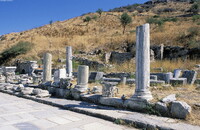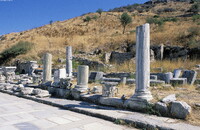| dc.coverage.spatial | Site: Ephesus, Aegean Region, Turkey | en_US |
| dc.coverage.temporal | ca. 50-400 (creation) | en_US |
| dc.creator | unknown (Ancient Roman) | en_US |
| dc.date | 50-400 | en_US |
| dc.date.accessioned | 2013-02-26T20:52:04Z | |
| dc.date.available | 2013-02-26T20:52:04Z | |
| dc.date.issued | 50-400 | en_US |
| dc.identifier | 196497 | en_US |
| dc.identifier.other | archrefid: 1569 | en_US |
| dc.identifier.uri | http://hdl.handle.net/1721.3/104005 | |
| dc.description | View of the east colonnade; Starting from the great theatre to the Library of Celsus, it is the portion of the sacred way that leads past Panayirdagi to the Temple of Artemis. The construction of the marble road dates to the 1st century A.D, and it was rebuilt in the 5th century. The western side of the road is enclosed by the agora wall, and on the wall is a higher platform, which was constructed during the reign of Nero. It was built over the wall, for pedestrians. On the marble road, there are some drawings believed to be an advertisement of the brothel. Source: Ephesus [ An OTTI Travel Company, Turkey website]; http://www.ephesus.us/ (accessed 7/8/2008) | en_US |
| dc.format.medium | marble | en_US |
| dc.rights | © Scott Gilchrist, Archivision, Inc. | en_US |
| dc.subject | business, commerce and trade | en_US |
| dc.subject | domestic life | en_US |
| dc.subject | genre | en_US |
| dc.subject | City planning | en_US |
| dc.subject | Roads Design and construction | en_US |
| dc.subject | transportation | en_US |
| dc.subject | Imperial (Roman) | en_US |
| dc.title | Marble Way | en_US |
| dc.title.alternative | Ephesus: Marble Way | en_US |
| dc.type | image | en_US |
| dc.rights.access | Licensed for educational and research use by the MIT community only | en_US |
| dc.identifier.vendorcode | 1A3-R-T-E-3-A4 | en_US |
| vra.culturalContext | Ancient Roman | en_US |
| vra.technique | construction (assembling) | en_US |
| vra.worktype | excavation (site) | en_US |
| vra.worktype | street | en_US |
| dc.contributor.display | unknown (Ancient Roman) | en_US |



